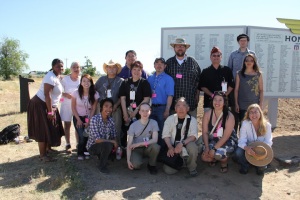March 19, 2014
The Minidoka Pilgrimage and Continuing the Legacy
This piece was contributed by Chanda Ishisaka, co-chair of the Minidoka Pilgrimage Planning Committee
http://chiyokomartinez.wordpress.com/2014/03/16/the-minidoka-pilgrimage-and-continuing-the-legacy/
The Minidoka Pilgrimage and Continuing the Legacy
Today I received the news that my friend and fellow Minidoka Pilgrimage Planning Committee member passed away. Frank was a baby during World War II when his family was told to leave Bainbridge Island and go to the War Relocation camp in Manzanar, California and later sent to the camp called Minidoka in Idaho. To me, Frank was my elder, a man I respected and looked for guidance and wisdom. With his passing, I can’t help but reflect what the Minidoka Pilgrimage Planning Committee has meant to me over the years.
I joined the Minidoka Pilgrimage Planning Committee in 2009 whenI was a graduate student and received a scholarship to attend the pilgrimage. I am a yonsei, fourth generation Japanese American where my great grandparents were the first to immigrate to this country in the late 1800′s. My family was incarcerated at several camps during WWII: Tule Lake in California, Gila River in Arizona, and Heart Mountain in Wyoming. My grandfather enlisted in the U.S. Military Intelligence Service. But like most other Japanese Americans, my family did not talk about the incarceration experience although it has impacted us and our communities during World War II and continues to this day.
As a kid I spent a lot of time at my auntie’s house where also lived my grandfather and his sister, my great aunt, who I consider my obachan (grandma). If I could characterize my interactions with my grandparents I would say we were always polite, obedient, and with very few words exchanged. This is where I mastered indirect communication. I could tell my grandparents wanted to know about my parents, about us children, and our upbringing but didn’t know how to talk to us. One day my obachan waved a can of soup and said to me, “Is this what your mother makes you?” I nodded and then she started to shake her head and mutter to my grandpa in Japanese. I know they thought we lived like barbarians back at home with my two working parents.
When my parents were going through hard times I spent the summer with my grandparents. My grandpa wouldn’t say anything but once a week he would plan an outing for us. He would just walk out of his room and tell my brother, sister and I to get in the car. He took us to his favorite lake, the mall, the movies, the zoo, and the beach and fishing pier. One of the funniest moments was when he turned on the car and started playing the Mexican radio station. Then after awhile on the road he looked at me and said, “Is this what your mother plays to you?” I looked over to my brother and started smiling. My mother is Mexican and I think that’s what brought a lot of confusion and speculation from my grandparents. I told my grandpa I don’t listen to that kind of music and reminded him we don’t know Spanish. He nodded his head and changed the station.
Fast forward to 2009 and attending the Minidoka Pilgrimage. I was a transplant to Seattle from Los Angeles and thought going to this pilgrimage would help me connect to my roots and also to learn about the Japanese community from the Pacific Northwest. The Minidoka Pilgrimage is a four-day trip in Twin Falls, Idaho where we visit the former Minidoka incarceration camp which was one of ten incarceration camps in the United States for people of Japanese ancestry. We offer an option to take a coach bus for twelve hours from Seattle, Washington to Idaho. What happens on this bus ride to and back from Minidoka is transformational and hard to explain. Yes, it’s exhausting, but allows a moment to bond with a group of strangers where we share stories, watch war related films, and be together through the entire journey.
On the Minidoka Pilgrimage I was able to understand and find solace of the issues that have impacted the Japanese American community for generations. I was able to have the inter-generational dialogue and the tough conversations I didn’t realize I was craving. When I walked on the grounds of the Minidoka camp I found myself gravitate to a woman that looked like myobachan. I asked her how she was feeling being back at Minidoka. I expected her to say she was fine or having a good time but instead she looked at me and said, “I’m angry. Why did they have to send us here?”
After talking to her I thought of my own grandma who was my age in camp, and in this crappy, desolate location. Angry and sad tears came down my face as I closed my eyes and sent a prayer to my grandma. I could now see the trauma and racism my ancestors experienced in this country, and being on that land made me feel closer to my ancestors.
My plan after the pilgrimage was to talk to my grandfather. I was going to tell him all about the trip and for us to talk more about our family experience in camp and after camp. I wanted to ask his permission to request from the United States National Archives our family members war relocation authority files where I could get all of their documentation during camp. Yet I never got to ask my grandpa. On July 18, 2009 I was volunteering for the Minidoka Pilgrimage Committee at the Seattle Buddhist Temple during their Bon Odori festival when I received the news from my dad that my grandpa passed away.
I had a hard time opening up to others about my grandpa’s death. Again I was reminded by my indirect communication style and how my grandparents and I liked to bury our emotions and be stoic. I lied to my boss and co-workers saying I needed to go home for vacation instead of the reality that I was going back for my grandpa’s funeral.
In my own healing process with my grandpa’s passing, I decided to stay involved with the Minidoka Pilgrimage Planning Committee. Every year I attend the pilgrimage, I cry. I miss my grandpa. But I also laugh and smile. Every year I find community, compassion, and kinship.
At the end of the Minidoka pilgrimage two years ago I was waiting at the airport in Idaho to return to Seattle with a group of the community leaders including Frank. Together we strategized and discussed the importance of the pilgrimage and what we saw for the future. I was in awe of these elders who were the leaders in the community and who included me in this process. Then the elders shared with me how the community is changing. The elder generation who was in camp have been dying off by the minute. They foresaw the pilgrimage having to change with the next generation and they were going to need me to help take over with the leadership. I shrugged and shook my head at their comments. I believed they shouldn’t be talking like that and they would be here for many more years to continue on the pilgrimage.
Not too much later, I was asked by the Minidoka Pilgrimage Planning Committee to co-chair the committee. I could hear my grandfather in my ear, encouraging me to do it, and I said yes. With the support of Frank, the other pilgrimage committee members and my community, I am happy to be part of such a great group of people.
I didn’t know what I was signing up for back in 2009 by going to the Minidoka Pilgrimage, but in the process I was able to learn more about my family, my community, and finding my voice. It is important for me to continue the legacy of my grandpa and my ancestors, and now also people like Frank and those I have met on the pilgrimage who have passed on.
March 16, 2014
Remembering Dr. Frank Kitamoto
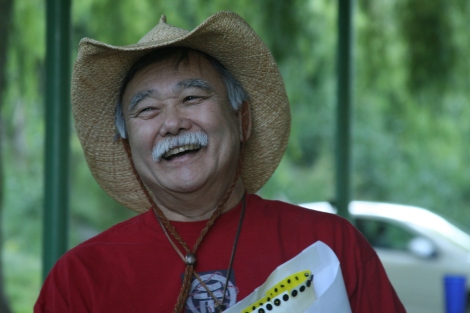
It is with great sadness that we share that we lost one of our committee members, Dr. Frank Kitamoto on March 15, 2014. Frank was a young toddler when he, along with his family, were sent to Minidoka during World War II. He shared the lessons of the incarcerations to: various school groups, community organizations, friends and just anyone who was willing to listen. Frank was active not just on the Minidoka Pilgrimage Planning Committee, but also on the Friends of Minidoka Board and as President of the Bainbridge Island Japanese American Community Executive Board to just name a few. He will be remembered for his relentless spirit and energy; and his never-ending passion for civil rights. Frank, we thank you for your dedication to us and for all the work you did with the incarceration experience and sharing your story. We will miss you greatly. Nidoto Nai Yoni
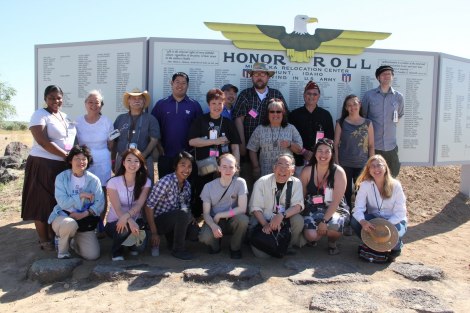 2011 Pilgrimage Committee Members
2011 Pilgrimage Committee Members
March 8, 2014
2014 Minidoka Pilgrimage Youth Scholarships
In an effort to continue to provide an experience of social justice in action, and to create diverse input, participation and energy, the Minidoka Pilgrimage Committee is proud to offer unique scholarship opportunities to students.
Student scholarship recipients are asked to assist with work activities before, and during, the 2014 Pilgrimage. All scholarship recipients are encouraged to be involved in the planning of subsequent Pilgrimages. The pilgrimage will be taking place this year from June 19- June 22.
Find the Scholarship form here: http://www.minidokapilgrimage.org/scholarships.html
Application deadline: Monday, April 14, 2014
The Scholarship Recipient will receive:
•Complimentary attendance to the 2014 Minidoka Pilgrimage. This includes transportation to and from Idaho from Seattle, registration costs, lodging, and all meals while attending the pilgrimage.
•The opportunity to serve on the Minidoka Pilgrimage Planning Committee and to assist with the planning for future pilgrimages.
Eligibility and Expectations:
•Must be a student at least 18 years of age or graduated from college in the past one or two years. Undergraduate and graduate students can apply.
•Is able to participate for the entire pilgrimage trip from Thursday, June 19 – Sunday, June 22, 2014.
•Will assist the Minidoka Planning Committee with duties while attending the pilgrimage
•Is able to attend the Minidoka Pilgrimage Planning Committee meetings prior to the pilgrimage
•Will create a project of your interest relating to the Minidoka Pilgrimage. This project can either be educational, a way to document the pilgrimage, or a way to help the Pilgrimage Committee. Past projects include: video of the pilgrimage, picture show, and creating a Pilgrimage evaluation survey.
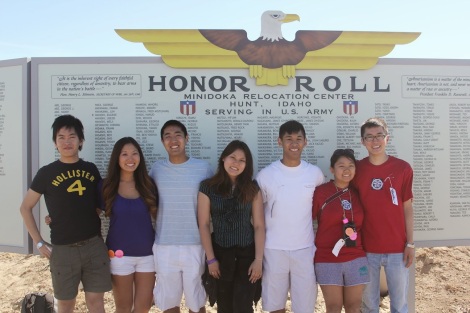
2013 Minidoka Pilgrimage Youth Scholarship winners
Photo by: Ryan Kozu
February 25, 2014
2014 Day of Remembrance Taiko Festival
Thank you to everyone who came out and supported this year’s Day of Remembrance Taiko Festival at Seattle University. The Minidoka Pilgrimage Planning Committee wants to especially thank: UW Taiko Kai, Ringtaro and the School of Taiko, Okinawa Kenjin-Kai, Seattle Matsuri Taiko, Kaze Daiko and Seattle Kokon Taiko for participating in this year’s festival.
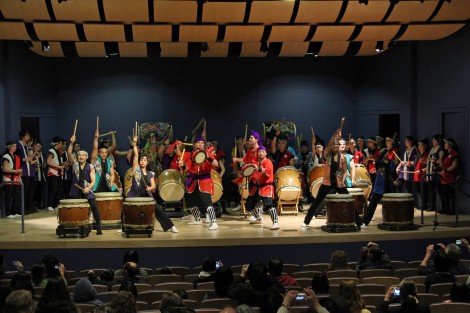
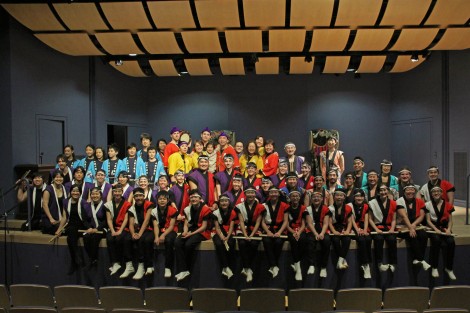
January 28, 2014
Minidoka Pilgrimage 2014 Taiko Fundraiser
Buy your tickets here at Brown Paper Tickets:
http://dayofremembrancetaiko.bpt.me
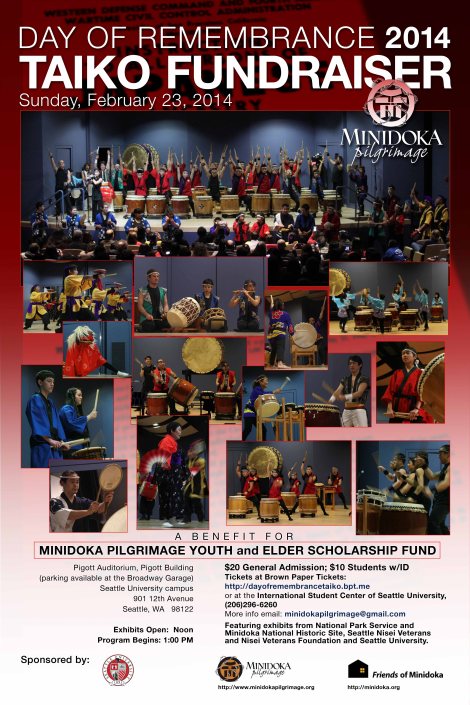
FOR IMMEDIATE RELEASE
Minidoka Pilgrimage 2014 Taiko Fundraiser
Seattle, WA – December 18, 2013 – In recognition of Japanese American Day of Remembrance and the 72nd anniversary of the signing of Executive Order 9066, the Minidoka Pilgrimage Planning Committee and Seattle University are proud to present the Day of Remembrance 2014 Taiko Fundraiser on Sunday, February 23, 2014. The event will open at Noon and the concert featuring taiko groups from throughout the Seattle area will begin at 1:00 p.m. Sunday, February 23rd in the Pigott Building on the campus of Seattle University, 901 12th Avenue in Seattle, WA. Tickets are $20 general, $10 for students with ID and can be purchased through Brown Paper Tickets, http://dayofremembrancetaiko.bpt.me. Parking is provided at the Broadway Garage of Seattle University. If attendees purchase tickets through Will Call, no actual tickets will be given, so please make sure to bring identification. For those unable to purchase tickets on-line, they will be available at the International Student Center of Seattle University in the James C. Pigott Pavilion for Leadership.
A free exhibit in the Paccar Atrium directly outside the auditorium will open at Noon and will feature displays from the Law Library of Seattle University, National Park Service and the Minidoka National Historic Site, and the Seattle Nisei Veterans and Nisei Veterans Foundation. Also featured will be original photographs in a collection called “My Minidoka” by Johnny Valdez y Uno. Raffle ticket sales and a general store will also be in the atrium to help support the work of the Minidoka Pilgrimage Planning Committee.
The concert benefits the annual Minidoka Pilgrimage to Twin Falls, Idaho. This will be the 12th year of the Pilgrimage. As one of the ten original War Relocation Authority (WRA) camps, the Minidoka National Historic Site is currently a part of the National Park Service and continues to be developed as an educational site. Currently there is an original Mess Hall and Barrack at the site of Block 22, as well as an original Fire Station, Warehouse and Root Cellar. Recent improvements include the Honor Roll, dedicated in 2011, which lists the names of approximately 1,000 individuals that enlisted from Minidoka and served in the army and 2014 will include the dedication of a restored guard tower at the entrance area.
The Day of Remembrance recognizes the date, February 19, 1942, when President Franklin D. Roosevelt signed Executive Order 9066, which forced 120,000 Japanese American citizens and legal residents into concentration camps during World War II solely based upon their Japanese descent.
Sponsors of this event include: The International Student Center, the Korematsu Center for Law and Equality, Seattle University and the Minidoka Pilgrimage Planning Committee.
Dale H. Watanabe
watanad@seattleu.edu
Minidoka Pilgrimage Committee/Seattle University
November 6, 2013
Book Review: Sad pieces of Idaho’s past
Minidoka: An American Concentration Camp by Teresa Tamura can be purchased on Amazon
http://www.idahostatesman.com/2013/11/02/2848744/sad-pieces-of-idahos-past.html
Book Review: Sad pieces of Idaho’s past
Published: November 2, 2013
By Janice Hildreth — Book Addicts
Synopses: In “Minidoka: An American Concentration Camp,” Teresa Tamura documents one of 10 such camps — the Minidoka War Relocation Center in Jerome County.
Her documentation includes artifacts made in the camp as well as the story of its survivors, uprooted from their homes in Alaska, Washington, Oregon and California. The essays are supplemented by 180 black-and-white photographs and interviews that fuse present and past.
Ultimately, her book reminds us of what happens when fear, hysteria and racial prejudice subvert human rights and shatter human lives.
The 1942 wartime incarceration of Japanese Americans forced 120,000 people to abandon their property and homes. Most were American citizens.
“ ‘Surviving Minidoka’ is a history book about the present as much as the past,” said series editor Melissa Lavitt, dean of the College of Social Sciences and Public Affairs at Boise State University.
“This is not a book about camp life,” said co-editor Todd Shallot. “It is an art book and a tribute. It is a book about how an event shaped race relations more than a story about the event itself.”
My take: I chose to highlight both of these books because they document a part of Idaho history that many would like to ignore or forget and are written from two unique viewpoints.
While both books tell stories of the people who lived at Minidoka, in “Minidoka: an American Concentration Camp” you get a historical perspective of the people incarcerated there.
Their narratives, accompanied by photos, both old and current, relay their personal viewpoints, then continue with a recounting of the paths their lives took after they left. These recitations, culled from newspaper accounts and personal interviews, are brief and compelling.
In “Surviving Minidoka,” the creators grasped what Aristotle meant by “the aim of art is to represent not the outward appearance of things, but their inward significance,” and concentrated on the effect Minidoka had on individuals as shown through personal photos, art and poetry.
The stories are in-depth, giving a perspective of the fire Minidoka set that fueled its residents’ later accomplishments.
Despite the beautiful photography, this book, with its wealth of data and documentation, reads more like a report, and was saved only by the personal stories that put heart in the book.
My rating: Both are beautiful books, well worth owning, if for no other reason than to remind ourselves that what happened once could happen again if we don’t learn from the past.
August 1, 2013
Johnny’s story
The words below are Johnny Valdez’s story. He shared his powerful story with all of the attendees at the 2013 Minidoka Pilgrimage.
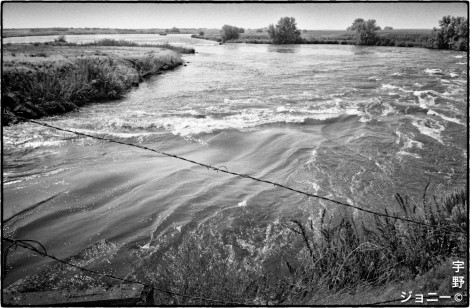
June 22, 2013
– Twin Falls, ID – My name is Johnny Valdez. I am a Seattle based photographer, and I currently have a running photo exhibition entitled, “My Minidoka”. I am the son of a Sansei mother, and a Latino American Father, Grandson of two Nisei who were once incarcerated here at Minidoka along with their families. As everyone has a story, this one is mine, and it is an extension of theirs’ as well.
I photograph what I love, and what draws me in. My Grandparents are no longer living, so it is with immense compassion and sensitivity that I go about photographing our surviving Nisei. This is because when I take that picture of what I am seeing, I am essential taking a picture of my own Grandparents, and that is what I love.
In camp, my Grandmother’s name was Porky Noritake. She went to Hunt High School, and was in a band called the Minidoka Matinee. She sang songs on the radio like “Shina No Yoru” and “Don’t Fence Me In”. Her older brother Yosh, was in the 442nd’s 100th Battalion, and was killed in action in Bruyeres, France during the rescue of the lost Texas Battalion.
My Grandfather’s name was Johnny Uno. He was four years older than Porky and graduated from Hunt High School in 1943. He went into the Army, and after training at Camp Shelby was assigned to the 442nd. He served in Italy, Switzerland, and Germany. After the war he went to school on the G.I. Bill, and later became a podiatrist.
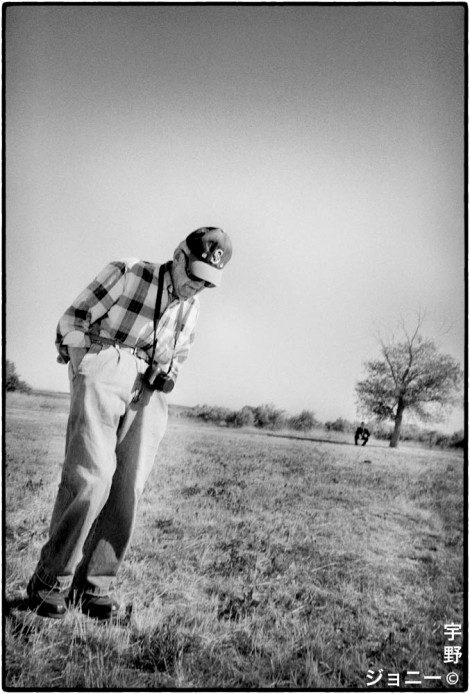
My work entitled “My Minidoka” is dedicated to my grandparents, Johnny and Porky Uno.
“My Minidoka” is a personal project and an expression that I have been incubating for several years. It is my take on the Minidoka experience through my eyes and its impact on my own life. It comes from my heart. And it is an ongoing lifelong study of ideas and emotion that continues to evolve and manifest, as I often come to revisit it. It has had a profound effect on who I am as a person.
I was not there at Minidoka during the Second World War, but I have a deep emotional connection to it, as it has greatly affected my life. Like many defining moments in the lives of people, this for me was an impacting awakening of sorrow and tragedy. I first learned of the wrongful injustices and incarceration of a people, my people, when I was 8 years old. It was the 28th of May, 1990 – Memorial Day. This day would forever change the course of my life, and this would be the day when I would come to know Minidoka.
My father woke me up in tears repeating my name, “Johnny, Johnny, Johnny…” Soon after, he told me that there had been a car accident. “Grandpa died,” he said, “Auntie Mickey died and Uncle Toshi too,” he continued. I was breathless and in unimagined disbelief. It was awful. In tears I asked, “What about Grandma?” “Grandma is alright,” he said. And although I was experiencing a pain that I had never felt before, I was greatly relieved that I still had my grandmother.
The four of them were on their return journey home to Seattle from a pilgrimage to Minidoka when this fateful tragedy occurred. My father further explained to me the circumstances, significance and purpose of my grandparents’ and their siblings’ journey to this place in Idaho.
I was extremely close to my grandparents, and learning about mortality and impermanence in this traumatic way, I remember thinking that I never wanted to leave my grandmother’s side. During those days I even used to sleep on the floor next to her bed. I found myself extremely curious and inquisitive about these unique lives and the history of my grandparents, and my grandmother was my key to the past.
For years she and I shared in great conversations, and I was full of questions. She spoke of the shame, struggle and trauma of her people that once was, and which now transcends into great pride. Our people lost everything. We have shed our own blood to prove our loyalty and allegiance to the only country that we have ever called home.
Now as I take on this journey with this project, I navigate my way through the past. This work is a homage to my people. It is with immense compassion that I capture these moments, expressions and feelings. My images tend to carry more of a heavier tone and feeling, but in them there is love, and that comes from my heart. This is why I take these pictures. In the words of my Grandmother, “Shoganai! Gaman!”
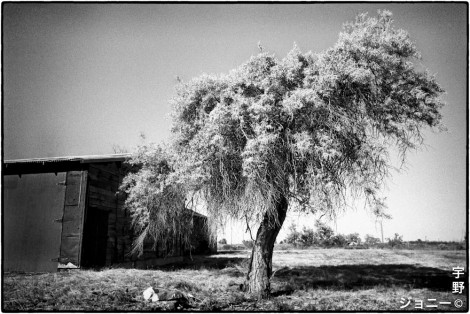
July 14, 2013
Minidoka Pilgrimage 2013 Generations on Common Ground
http://www.iexaminer.org/2013/07/minidoka-pilgrimage-2013-generations-on-common-ground
Minidoka Pilgrimage 2013 Generations on Common Ground
THE INTERNATIONAL EXAMINER – JULY 8, 2013
From June 20th to June 23rd, about 200 former Japanese American incarcerees, their family members and friends gathered for the 11th Annual Minidoka Pilgrimage just outside Twin Falls, Idaho. More than 71 years have past since 13,000 Japanese Americans residing in the Pacific Northwest were removed from their homes and sent to a stark Minidoka Relocation Center in Idaho. Pilgrimage participants — many of whom had spent years at the camp as young children — dedicated much of their time touring and reflecting on incarceration grounds, now the Minidoka National Historic Site.
They connected their experiences to advocacy at a civil liberties symposium on the campus of the College of Southern Idaho, helping to ensure all the stories and history of the Minidoka experience are passed on and that no group of people is ever targeted and incarcerated without due process again.
One of its young attendees Johnny Valdez is a vessel of that history, and inheritor of those stories. A Seattle-based photographer, and the son of a Sansei mother and Latino-American father, Valdez is the grandson of two Nisei who were incarcerated at Minidoka with their families.
“In camp, my grandmother’s name was Porky Noritake,” he says. “She went to Hunt High School and was in a band called the Minidoka Matinee. She sang songs on the radio like ‘Shina No Yoru’ and ‘Don’t Fence Me In.’ ”
Valdez incorporates his Japanese heritage and grandparents’ identities into his artist name, “Johnny Valdez y Uno.”
“My Grandfather’s name was Johnny Uno,” he says. “He was four years older than Porky and graduated from Hunt High School in 1943. He went into the Army, and after training at Camp Shelby was assigned to the 442nd. He served in Italy, Switzerland and Germany. After the war, he went to school on the GI Bill, and later became a podiatrist.”
Valdez’s photo essay honors his grandparents and all Nisei survivors.
“I photograph what I love and what draws me in,” he says. “My grandparents are no longer living, so it is with immense compassion and sensitivity that I go about photographing our surviving Nisei, because, essentially what it is that I am seeing as well as what I am taking a picture of, are my own grandparents. And that is what I love.”
Valdez captures the experience of his first Minidoka pilgrimage in 2012 in the exhibit, “My Minidoka,” which is on display at the Japanese Cultural and Community Center of Washington on 1414 South Weller Street in Seattle through Wednesday, July 17th. For more information about the exhibit, please contact admin@jcccw.org.
Children of the Issei
Children of the Issei by Dana Mar
Upon a dream
In a ship set on the path of the rising sun
I sailed under the billowing black of a Japanese steam ship
The sea roared her protest and the ship creaked fear into our sleep
We, the voyagers of the Japanese, traversed the ocean over time and uncertain promises
We brought our bags, our skills, our culture, our dreams, and our legacy to the
Land of the Free
They discovered the red and the white of our nations
Were separated by the blue of the ocean, in which our stars fell one by one
Shot down by fighter pilots and blown to bits in Pearl Harbor
In a ship set on the path to the golden waves of grain
I ceased being Japanese and became the enemy
In the nightmare of war
I was the first-born in the United States
Just a Nisei in Issei arms
How could they, those Americans just like us, say
These nurturing arms are the arms of the enemy?
As if my parents had never braved the blue waves to live under the stars and stripes
As if my loving mother could kill as well as she breathed life in a family
My family
Put into “camps” so desolate and so removed from our homes that someone once said
Will they let us die here or kill us first?
Two bags and our own arms to hold the past and future of every family
We were given mere days to leave home behind
All she could carry were her children and her American dream
Shattered by Japanese bombs
Those days were framed in barbed wire and dust
They spit Jap in my eyes and blinded me to hope
We were all faithful to the red, white, and blue
So I swore on my mother’s fear
My children would not be Japanese
Because I was equal in the eyes of God
Equal in my Asian eyes
The eyes that stood witness to the red of the rising sun
The red of the blood shed for atomic bombs that blew up the whites of our eyes
I became Sansei
I grew up knowing little of what that meant
I grew up as an American
Not quite knowing why other kids asked how I spoke such good English
The war had not ended with a mushroom cloud
I fought the shrapnel that threatened to cut my feet as I walked
Down a dusty road
And back to a place where barbed wire pierced my eyes
Pierced my heart
And told me that I had to say something
I woke up and I was Yonsei
Fourth generation in the United States
1942 became a paragraph briefly mentioned in a small classroom
I lived in an alien nation
In alienation
As my peers were deceived by Asian stereotypes
I was a type of person
But somehow not quite a person
My mother’s words echoed on the cases of three men
Korematsu, Hirabayashi, Yasui
In three generations of Japanese Americans
I found a suffering and a sadness that embraced my heart, seventy years later, in tears
But in that ship set on the path of the rising sun
I rose the sails of my voice and became more than my face and my meager height
The words of those who lost themselves in a concentration camp
Resonated stronger than the shockwaves of Nagasaki and Hiroshima
Japanese American became a badge of pride
It was silly when friends became honorary Asians
But from a people feared and hated so strongly once before
I became the dream
Once upon a dream
In a ship set on the path of the rising sun
Over an ocean of every color in one
I dreamt of being an immigrant
An enemy
A prisoner
A mother
A daughter
A legacy
A voice
I opened my eyes to see the sun rise
And woke together with purpose in my voice
And determination in my eyes
We were all American
All proud children of the Issei
A Wooden Heart
A Wooden Heart by Dana Mar
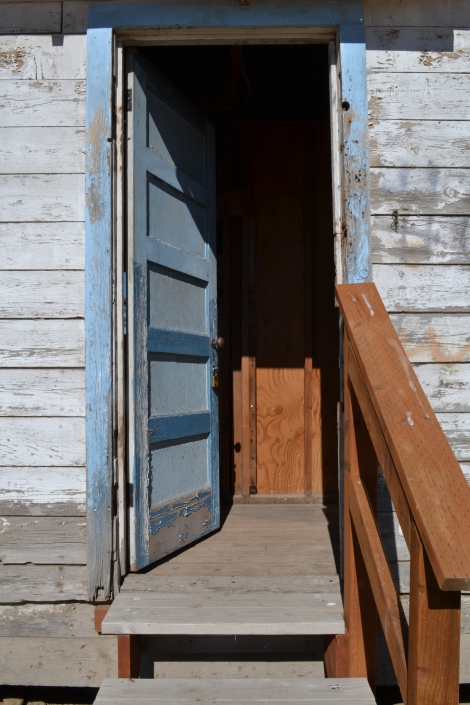
They close their eyes and hide their tears
Not looking at the horrible sights and fears
Know happiness and laughter, don’t look away
I can’t help anyone with nothing to say
Thus why I keep living with care
I protect all I can, just try me: I dare
We thought we would die in that lonesome camp
The face of my race became a terrorists’ stamp
I opened the door to a shoddy shack
And lived with dust blowing through every crack
To make the most of our situation
We built schools and a fire station
Some volunteered for the war effort
Loyalty to the States never fell short
Regretfully hope was lost at times
When we remembered our nonexistent crimes
To doubt one’s self, is to doubt another
Part of you might be a friend or brother
Don’t jump to judge by nationality
Even you are a native fallacy
In Minidoka I had a wooden heart
After these years, I’ve got to restart
Fly above the trees, soar below the stars
It is a process now, to heal all the scars
A smile can brighten even the darkest days
Just one rain-drop laugh, clears away the haze
I returned to that desolate campsite
The memories came back in new light
Feelings of fear and resentment
Melted away in American testament
I felt the tears passing through that door
Seeing the desolation of camp once more
I looked at it thoughtfully from afar
A blue wooden door standing just ajar
Where now my heart stands wide open
I am made of stronger stuff, unbroken
The future of the past is held in Yonsei hands
Where now that old wood building stands
Hope is rebuilt for a future of
Uneasy prejudice turned communal love
